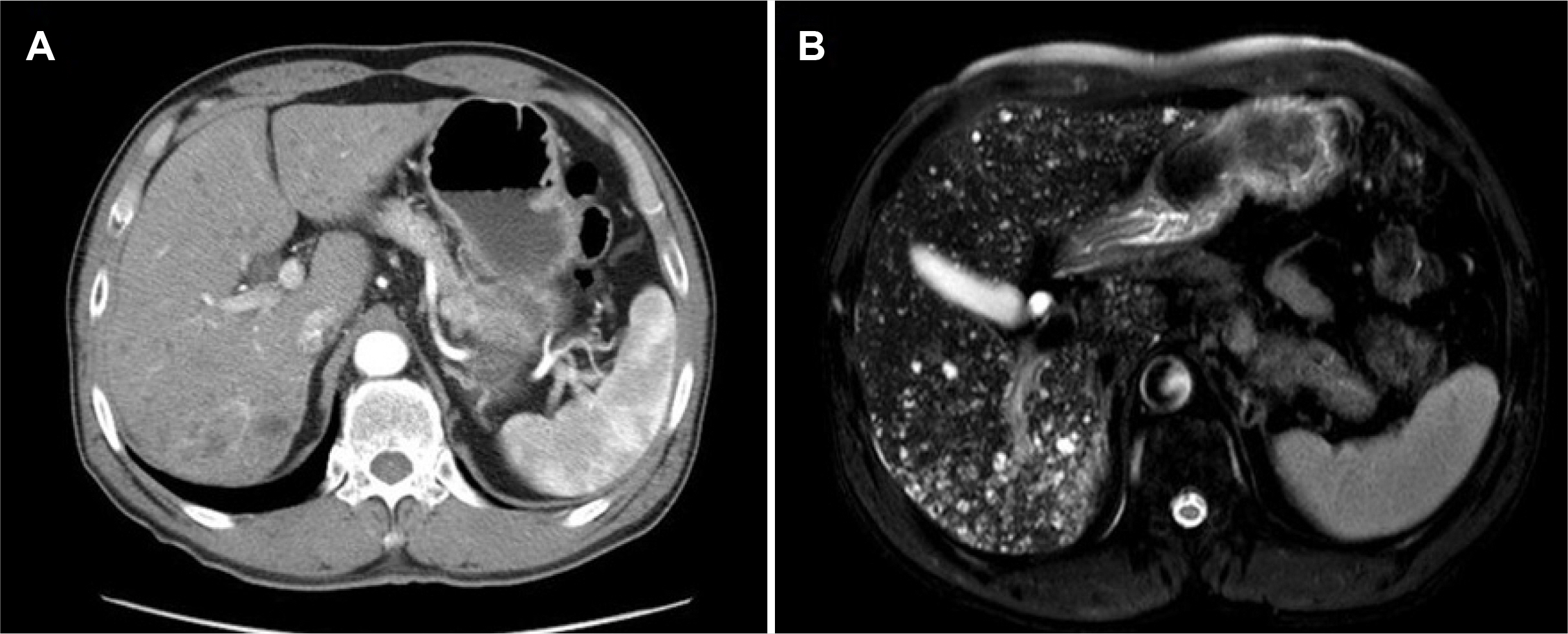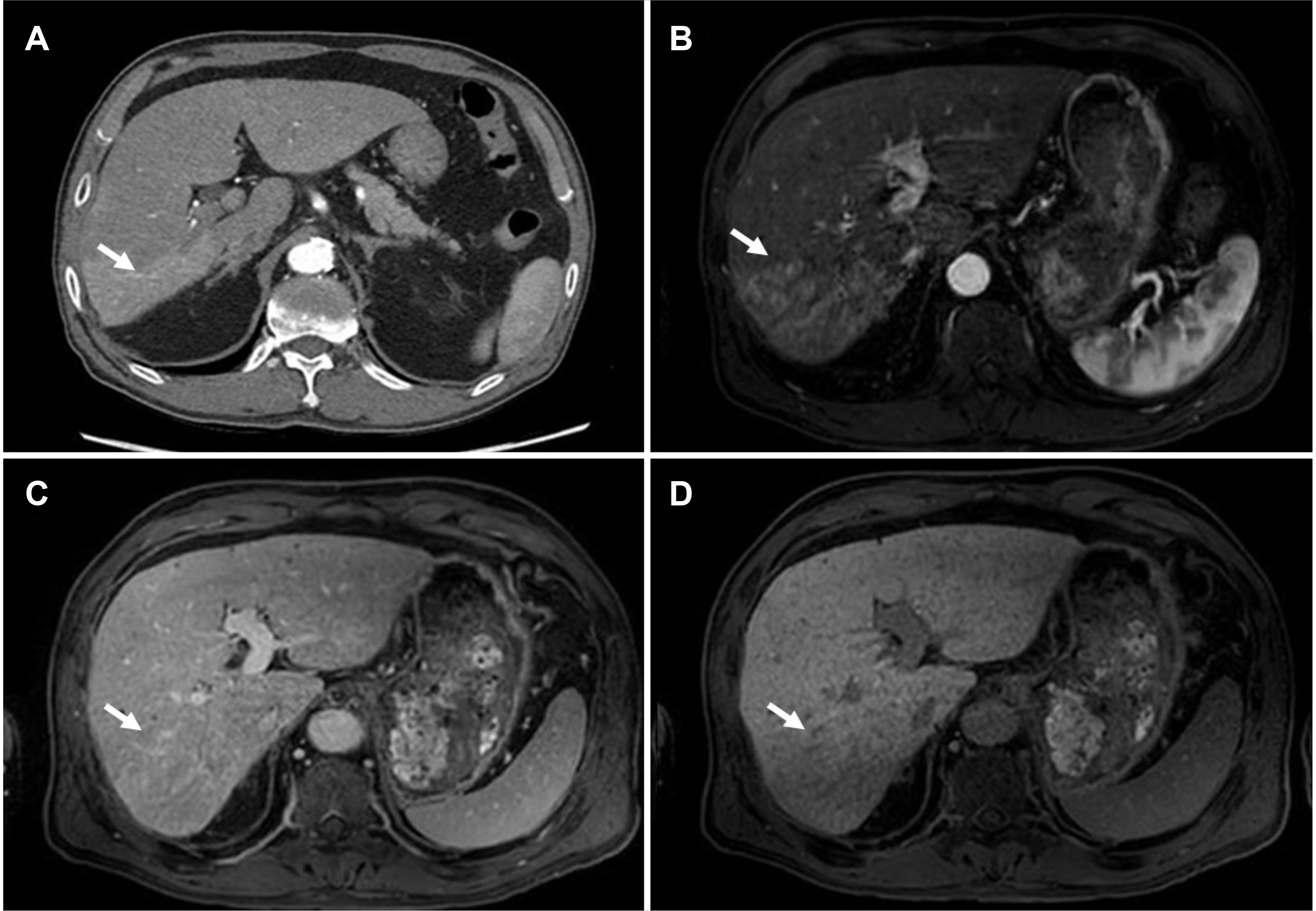Korean J Gastroenterol.
2023 Sep;82(3):145-150. 10.4166/kjg.2023.095.
Intrahepatic Cholangiocarcinoma Arising from Biliary Hamartomas in Patients with Recurrent Acute Cholangitis: A Case Report and Literature Review
- Affiliations
-
- 1Department of Internal Medicine, Chungbuk National University Hospital, Cheongju, Korea
- 2Department of Internal Medicine, Chungbuk National University College of Medicine, Cheongju, Korea
- 3Department of Pathology, Chungbuk National University Hospital, Cheongju, Korea
- 4Department of Pathology, Chungbuk National University College of Medicine, Cheongju, Korea
- KMID: 2546517
- DOI: http://doi.org/10.4166/kjg.2023.095
Abstract
- Biliary hamartomas are tumor-like malformations of the liver. Biliary hamartomas are a type of fibrocystic disorder originating from ductal plate malformation and are typically considered benign, but with the risk of malignant transformation. In this case report, we present a rare occurrence of intrahepatic cholangiocarcinoma (ICC) that developed from biliary hamartomas, along with a literature review. A 76-year-old man with a diagnosis of biliary hamartomas had a history of recurrent cholangitis for 12 years, necessitating cholecystectomy, ERCP, and repeated antibiotic treatments. During his last episode, imaging studies revealed a hypervascular infiltrative mass in the right posterior liver segment. A liver biopsy confirmed adenocarcinoma and subsequent surgical pathology revealed ICC originating from biliary hamartomas. Chronic inflammation in the bile duct associated with biliary hamartomas may serve as a potential trigger for malignant transformation, as observed in this case. Therefore, close surveillance is essential for patients with biliary hamartomas presenting with infectious complications.
Figure
Reference
-
1. Parekh V, Peker D. 2015; Malignant transformation in Von-Meyenburg complexes: Histologic and immunohistochemical clues with illustrative cases. Appl Immunohistochem Mol Morphol. 23:607–614. DOI: 10.1097/PAI.0000000000000132. PMID: 25789533.2. Sheikh AAE, Nguyen AP, Leyba K, et al. 2022; Biliary duct hamartomas: A systematic review. Cureus. 14:e25361. DOI: 10.7759/cureus.25361. PMID: 35774682. PMCID: PMC9236677.3. Armutlu A, Quigley B, Choi H, et al. 2022; Hepatic cysts: Reappraisal of the classification, terminology, differential diagnosis, and clinicopathologic characteristics in 258 cases. Am J Surg Pathol. 46:1219–1233. DOI: 10.1097/PAS.0000000000001930. PMID: 35778790.4. Li QQ, Guo XZ, Li HY, Qi XS. 2020; Portal hypertension in a patient with biliary hamartomas: A case report. World J Clin Cases. 8:1745–1751. DOI: 10.12998/wjcc.v8.i9.1745. PMID: 32420308. PMCID: PMC7211530.5. Yang XY, Zhang HB, Wu B, Li AJ, Fu XH. 2017; Surgery is the preferred treatment for bile duct hamartomas. Mol Clin Oncol. 7:649–653. DOI: 10.3892/mco.2017.1354. PMID: 28855998. PMCID: PMC5574177.6. Sinakos E, Papalavrentios L, Chourmouzi D, Dimopoulou D, Drevelegas A, Akriviadis E. 2011; The clinical presentation of Von Meyenburg complexes. Hippokratia. 15:170–173. PMID: 22110302. PMCID: PMC3209683.7. Bloustein PA. 1977; Association of carcinoma with congenital cystic conditions of the liver and bile ducts. Am J Gastroenterol. 67:40–46.8. Heinke T, Pellacani LB, Costa Hde O, Fuziy RA, Franco M. 2008; Hepatocellular carcinoma in association with bile duct hamartomas: report on 2 cases and review of the literature. Ann Diagn Pathol. 12:208–211. DOI: 10.1016/j.anndiagpath.2006.12.003. PMID: 18486898.9. Ettel M, Eze O, Xu R. 2015; Clinical and biological significance of precursor lesions of intrahepatic cholangiocarcinoma. World J Hepatol. 7:2563–2570. DOI: 10.4254/wjh.v7.i25.2563. PMID: 26557948. PMCID: PMC4635141.10. Jain D, Sarode VR, Abdul-Karim FW, Homer R, Robert ME. 2000; Evidence for the neoplastic transformation of Von-Meyenburg complexes. Am J Surg Pathol. 24:1131–1139. DOI: 10.1097/00000478-200008000-00011. PMID: 10935654.11. Tsokos CG, Krings G, Yilmaz F, Ferrell LD, Gill RM. 2016; Proliferative index facilitates distinction between benign biliary lesions and intrahepatic cholangiocarcinoma. Hum Pathol. 57:61–67. DOI: 10.1016/j.humpath.2016.06.019. PMID: 27396933. PMCID: PMC5250508.12. Lindgren AG, Hansson G, Nilsson LA. 1961; Primary carcinoma arising in congenital liver in conjunction with miliary cholangiomatosis. Report of case. Acta Pathol Microbiol Scand. 52:343–348. DOI: 10.1111/j.1699-0463.1961.tb03202.x. PMID: 14465463.13. Homer LW, White HJ, Read RC. 1968; Neoplastic transformation of v. Meyenburg complexes of the liver. J Pathol Bacteriol. 96:499–502. DOI: 10.1002/path.1700960231. PMID: 5698714.14. Börnfors M. 1984; The development of cholangiocarcinoma from multiple bile-duct adenomas. Report of a case and review of the literature. Acta Pathol Microbiol Immunol Scand A. 92:285–289. DOI: 10.1111/j.1699-0463.1984.tb04405.x. PMID: 6093427.15. Honda N, Cobb C, Lechago J. 1986; Bile duct carcinoma associated with multiple von Meyenburg complexes in the liver. Hum Pathol. 17:1287–1290. DOI: 10.1016/S0046-8177(86)80575-5. PMID: 3793090.16. Dekker A, Ten Kate FJ, Terpstra OT. 1989; Cholangiocarcinoma associated with multiple bile-duct hamartomas of the liver. Dig Dis Sci. 34:952–958. DOI: 10.1007/BF01540285. PMID: 2470558.17. Burns CD, Kuhns JG, Wieman TJ. 1990; Cholangiocarcinoma in association with multiple biliary microhamartomas. Arch Pathol Lab Med. 114:1287–1289. PMID: 2174673.18. Hasebe T, Sakamoto M, Mukai K, et al. 1995; Cholangiocarcinoma arising in bile duct adenoma with focal area of bile duct hamartoma. Virchows Arch. 426:209–213. DOI: 10.1007/BF00192644. PMID: 7757293.19. Papadogiannakis N, Gad A, Sjöstedt S, Tour R, Thörne A, Seensalu R. 1996; Adenocarcinoid of the liver arising within an area of hamartoma with predominant bile duct component. J Clin Gastroenterol. 23:145–151. DOI: 10.1097/00004836-199609000-00018. PMID: 8877646.20. Yaziji N, Martin L, Hillon P, Favre JP, Henninger JF, Piard F. 1997; [Cholangiocarcinoma arising from biliary micro-hamartomas in a man suffering from hemochromatosis]. Ann Pathol. 17:346–349. French. PMID: 9471152.21. Kim YW, Park YK, Park JH, et al. 1999; A case with intrahepatic double cancer: hepatocellular carcinoma and cholangiocarcinoma associated with multiple von Meyenburg complexes. Yonsei Med J. 40:506–509. DOI: 10.3349/ymj.1999.40.5.506. PMID: 10565264.22. Blanc JF, Bernard PH, Carles J, Le Bail B, Balabaud C, Bioulac-Sage P. 2000; Cholangiocarcinoma arising in Von Meyenburg complex associated with hepatocellular carcinoma in genetic haemochromatosis. Eur J Gastroenterol Hepatol. 12:233–237. DOI: 10.1097/00042737-200012020-00016. PMID: 10741940.23. Röcken C, Pross M, Brucks U, Ridwelski K, Roessner A. 2000; Cholangiocarcinoma occurring in a liver with multiple bile duct hamartomas (von Meyenburg complexes). Arch Pathol Lab Med. 124:1704–1706. DOI: 10.5858/2000-124-1704-COIALW. PMID: 11079031.24. Wisniewski B, Tordjman G, Tran Van Nhieu J, Bettan L, Courillon-Mallet A. 2002; [Cholangiocarcinoma developing in von Meyenburg complexes in haemochromatosis]. Gastroenterol Clin Biol. 26:922–924. French. PMID: 12434102.25. Orii T, Ohkohchi N, Sasaki K, Satomi S, Watanabe M, Moriya T. 2003; Cholangiocarcinoma arising from preexisting biliary hamartoma of liver--report of a case. Hepatogastroenterology. 50:333–336. PMID: 12749215.26. Zimpfer A, Nebel B, Terracciano L, Stadelmann S, Koch H. 2007; Intrahepatic cholangiocellular carcinoma associated with von Meyenburg complexes: case report and review of literature. Diagnostic Pathology. 2(Suppl 1):S10. DOI: 10.1186/1746-1596-2-S1-S10.27. Song JS, Lee YJ, Kim KW, Huh J, Jang SJ, Yu E. 2008; Cholangiocarcinoma arising in von Meyenburg complexes: report of four cases. Pathol Int. 58:503–512. DOI: 10.1111/j.1440-1827.2008.02264.x. PMID: 18705771.28. Li WH, Tsang YW, Cheung MT. 2009; Cholangiocarcinoma arising from bile duct hamartoma. Surgical Practice. 13:83–85. DOI: 10.1111/j.1744-1633.2009.00450.x.29. Xu AM, Xian ZH, Zhang SH, Chen XF. 2009; Intrahepatic cholangiocarcinoma arising in multiple bile duct hamartomas: report of two cases and review of the literature. Eur J Gastroenterol Hepatol. 21:580–584. DOI: 10.1097/MEG.0b013e3282fc73b1. PMID: 19282767.30. Kim HK, Jin SY. 2011; Cholangiocarcinoma arising in von Meyenburg complexes. Korean J Hepatol. 17:161–164. DOI: 10.3350/kjhep.2011.17.2.161. PMID: 21757989. PMCID: PMC3304640.31. Yuan Y, Fu G, Wan F, Chen XL, Feng J. 2022; Imaging analysis of the malignant transformation of bile duct hamartomas in the liver: A case report and literature review. Exp Ther Med. 23:431. DOI: 10.3892/etm.2022.11358. PMID: 35607375. PMCID: PMC9121201.32. Gupta A, Pattnaik B, Das A, Kaman L. Von Meyenburg complex and complete ductal plate malformation along with Klatskin tumour: a rare association. BMJ Case Rep. 2016; Apr. 18. doi: 10.1136/bcr-2016-215220. DOI: 10.1136/bcr-2016-215220. PMID: 27090552. PMCID: PMC4840689.33. Eguchi S, Tajima Y, Yanaga K, Okudaira S, Furui J, Hayashi T, et al. 2004; Hilar bile duct cancer associated with preoperatively undetectable von Meyenburg complex--report of a case. Hepatogastroenterology. 51:1301–1303. PMID: 15362738.34. Nagano Y, Matsuo K, Gorai K, et al. 2006; Bile duct hamartomas (von Mayenburg complexes) mimicking liver metastases from bile duct cancer: MRC findings. World J Gastroenterol. 12:1321–1323. DOI: 10.3748/wjg.v12.i8.1321. PMID: 16534895. PMCID: PMC4124453.35. Neto AG, Dainiak C, Qin L, Salem RR, Jain D. 2007; Intraductal papillary cholangiocarcinoma associated with von Meyenberg complexes: a case report. Dig Dis Sci. 52:2643–2645. DOI: 10.1007/s10620-007-9777-5. PMID: 17394067.36. Sugawara T, Shindoh J, Hoshi D, Hashimoto M. 2018; Intrahepatic cholangiocarcinoma and portal hypertension developing in a patient with multicystic biliary microhamartomas. Malays J Pathol. 40:331–335.37. Panda N, Brackett D, Eymard C, et al. 2019; Liver Transplantation for recurrent cholangitis from Von Meyenburg complexes. Transplant Direct. 5:e428. DOI: 10.1097/TXD.0000000000000867. PMID: 30882033. PMCID: PMC6411223.
- Full Text Links
- Actions
-
Cited
- CITED
-
- Close
- Share
- Similar articles
-
- Clonorchiasis and its complications: cholangiogram revisited
- Biliary Tract & Pancreas; A Case of Cholangiocarcinoma Suggested as Developing in the Patient with Primary Sclerosing Cholangitis
- A Case of Common Bile Duct Cancer with Mucosal and Submucosal Spread to Gallbladder and Common Hepatic Duct
- A Case of Primary Sclerosing Cholangitis Localized at Intrahepatic Bile Duct
- Cholangiocarcinoma associated with recurrent pyogenic cholangitis: sonographic and CT findings




